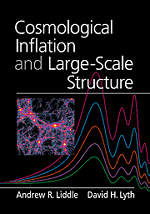Book contents
- Frontmatter
- Contents
- Frequently used symbols
- Preface
- 1 INTRODUCTION
- 2 THE HOT BIG BANG COSMOLOGY
- 3 INFLATION
- 4 SIMPLEST MODEL FOR THE ORIGIN OF STRUCTURE I
- 5 SIMPLEST MODEL FOR THE ORIGIN OF STRUCTURE II
- 6 EXTENSIONS TO THE SIMPLEST MODEL
- 7 SCALAR FIELDS AND THE VACUUM FLUCTUATION
- 8 BUILDING AND TESTING MODELS OF INFLATION
- 9 THE COSMIC MICROWAVE BACKGROUND
- 10 GALAXY MOTIONS AND CLUSTERING
- 11 THE QUASI-LINEAR REGIME
- 12 PUTTING OBSERVATIONS TOGETHER
- 13 OUTLOOK FOR THE FUTURE
- 14 ADVANCED TOPIC: COSMOLOGICAL PERTURBATION THEORY
- 15 ADVANCED TOPIC: DIFFUSION AND FREESTREAMING
- Appendix: Constants and parameters
- Numerical solutions and hints for selected examples
- References
- Index
4 - SIMPLEST MODEL FOR THE ORIGIN OF STRUCTURE I
Published online by Cambridge University Press: 05 June 2012
- Frontmatter
- Contents
- Frequently used symbols
- Preface
- 1 INTRODUCTION
- 2 THE HOT BIG BANG COSMOLOGY
- 3 INFLATION
- 4 SIMPLEST MODEL FOR THE ORIGIN OF STRUCTURE I
- 5 SIMPLEST MODEL FOR THE ORIGIN OF STRUCTURE II
- 6 EXTENSIONS TO THE SIMPLEST MODEL
- 7 SCALAR FIELDS AND THE VACUUM FLUCTUATION
- 8 BUILDING AND TESTING MODELS OF INFLATION
- 9 THE COSMIC MICROWAVE BACKGROUND
- 10 GALAXY MOTIONS AND CLUSTERING
- 11 THE QUASI-LINEAR REGIME
- 12 PUTTING OBSERVATIONS TOGETHER
- 13 OUTLOOK FOR THE FUTURE
- 14 ADVANCED TOPIC: COSMOLOGICAL PERTURBATION THEORY
- 15 ADVANCED TOPIC: DIFFUSION AND FREESTREAMING
- Appendix: Constants and parameters
- Numerical solutions and hints for selected examples
- References
- Index
Summary
Introduction
Thus far, we have seen how inflation can generate a flat and homogeneous Universe, from a wide range of initial conditions, through the classical evolution of a Universe dominated by the inflaton field. The true merit of inflation, however, is that it provides a theory of inhomogeneities in the Universe, which may explain the observed structures. These inhomogeneities arise from the quantum fluctuations in the inflaton field about its vacuum state, in other words, by the vacuum fluctuation.
The vacuum fluctuation generates a primeval density perturbation, of the type that cosmologists call Gaussian and adiabatic, and whose spectral index is close to 1. Such a primeval perturbation was regarded, even before the advent of inflation, as a viable candidate for the origin of large-scale structure and the then-unobserved cosmic microwave background (cmb) anisotropy (Peebles 1980). To understand the evolution of the primeval perturbation to the present, we need to know the nature and amount of the nonbaryonic dark matter, as well as the value of the cosmological constant. The simplest possibility is to have zero cosmological constant, and cold nonbaryonic dark matter giving critical density. The result fairly can be said to be the simplest plausible model for the origin of large-scale structure and the cmb anisotropy. It is called the cold dark matter (CDM) model (Peebles 1982; Blumenthal et al. 1984; Davis et al. 1985, 1992a).
In this chapter and the next, we study the simplest model, before describing some possible extensions of it in Chapter 6.
- Type
- Chapter
- Information
- Cosmological Inflation and Large-Scale Structure , pp. 58 - 104Publisher: Cambridge University PressPrint publication year: 2000



